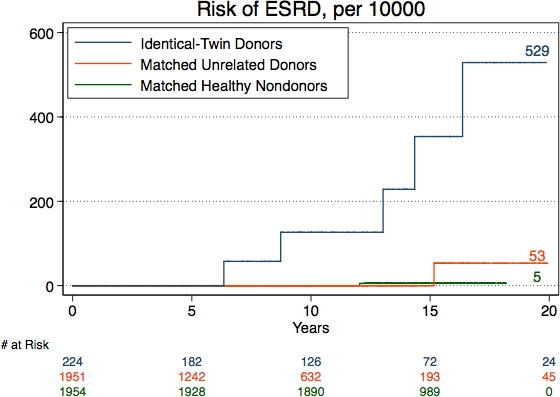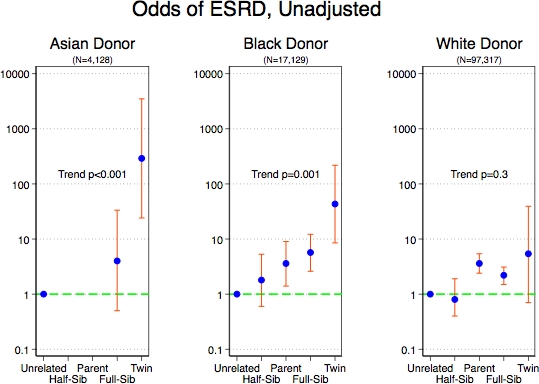Familial Risk of End-Stage Renal Disease in Healthy Live Kidney Donors
1Johns Hopkins University, Baltimore
2Saint Louis University, St. Louis.
Meeting: 2018 American Transplant Congress
Abstract number: 331
Keywords: Donation, Renal failure, Risk factors, Screening
Session Information
Session Name: Concurrent Session: Kidney Living Donor: Long Term Outcomes
Session Type: Concurrent Session
Date: Monday, June 4, 2018
Session Time: 4:30pm-6:00pm
 Presentation Time: 4:42pm-4:54pm
Presentation Time: 4:42pm-4:54pm
Location: Room 6A
Kidney donor candidates are rigorously evaluated so that only the lowest risk are cleared for donation; however, it is not standard practice to exclude candidates based on familial risk of ESRD. Our aim was to define the clinical significance of familial risk of ESRD in donors.
Methods We ascertained ESRD for a cohort of 136,091 donors (SRTR 10/1987-05/2016) and 20,024 nondonors (NHANES 10/1988-11/2008) over a median of 11y (IQR, 5-15y; max. 25y).
Results The 20-year risk of ESRD was 529 per 10,000 identical-twin donors (95%CI 208-1310), 53 per 10,000 matched unrelated donors (95%CI 8-372), and 5 per 10,000 matched healthy nondonors (95%CI 1-38). Compared with unrelated donors, the 20-year unadjusted odds of ESRD for identical twin donors were 290.7 for Asian donors (95%CI 24.1-3500), 43.2 for black donors (95%CI 8.5-218.2), and 5.4 for white donors (95%CI 0.7-39.3). In Cox regression models accounting for age and sex, a biological gradient of risk-increase was indeterminable for Asian donors (insufficient data), significant for black donors (trend p-value=0.001), and not statistically significant for white donors (trend p-value=0.08). Compared with unrelated donors, identical twins had a 50.2-fold risk increase (95%CI 9.7-259.8; p<0.001) if black vs. 4.6-fold increase (95%CI 0.6-34.1; p=0.1) if white; full-siblings or offsprings had 3.2-fold risk increase (95%CI 1.3-8.0; p=0.01) if black vs. 1.3-fold increase (95%CI 0.9-2.1; p=0.2) if white; and parents had a 1.9-fold increase (95%CI 0.7-5.4; p=0.2) if black vs. 1.3-fold-increase (95%CI 0.8-2.1; p=0.3) if white.
Conclusion Asian and black full-siblings or offsprings are potentially at very high-risk of ESRD; identical twins have several orders of magnitude greater risk than unrelated donors. Counseling of donor candidates with a family history of ESRD is warranted.
CITATION INFORMATION: Muzaale A., Massie A., Al Ammary F., Lentine K., Segev D. Familial Risk of End-Stage Renal Disease in Healthy Live Kidney Donors Am J Transplant. 2017;17 (suppl 3).
To cite this abstract in AMA style:
Muzaale A, Massie A, Ammary FAl, Lentine K, Segev D. Familial Risk of End-Stage Renal Disease in Healthy Live Kidney Donors [abstract]. https://atcmeetingabstracts.com/abstract/familial-risk-of-end-stage-renal-disease-in-healthy-live-kidney-donors/. Accessed December 14, 2025.« Back to 2018 American Transplant Congress


